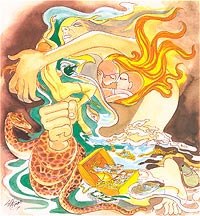TIPITAKA
TIPITAKA AND TWELVE DIVISIONS
Brief historical background
Sutta Pitaka
Vinaya Pitaka
Abhidhamma Pitaka
Twelve Divisions of Buddhist Canons
Nine Divisions of Buddhist Canons
Sutta Piṭaka
— The basket of discourses —Mahāsatipaṭṭhāna Sutta (DN 22) {excerpt} - all infobubbles— Attendance on awareness —
Dhammapada Verse 251-Panca Upasaka Vatthu-Craving Is The Worst Flood
ALL ABOUT USA-Illinois

TO









DN 22 - (D ii 290)
Mahāsatipaṭṭhāna Sutta
This sutta is widely considered as a the main reference for meditation practice.
Note:
infobubbles on all Pali words
PāḷiUddesa
|
EnglishIntroduction
|
|
|
|
Ekaṃ samayaṃ bhagavā kurūsu viharati kammāsadhammaṃ nāma kurūnaṃ nigamo. Tatra kho bhagavā bhikkhū āmantesi: |
|
|
– Bhaddante ti te bhikkhū bhagavato paccassosuṃ. Bhagavā etad-avoca: |
– Bhaddante answered the bhikkhus. The Bhagavā said: |
|
– |
– This, bhikkhus, is the path that leads to nothing but the purification |
|
Katame cattāro? Idha, bhikkhave, bhikkhu kāye kāyānupassī viharati ātāpī sampajāno satimā, vineyya loke abhijjhā-domanassaṃ. Vedanāsu vedanānupassī viharati ātāpī sampajāno satimā, vineyya loke abhijjhā-domanassaṃ. Citte cittānupassī viharati ātāpī sampajāno satimā, vineyya loke abhijjhā-domanassaṃ. Dhammesu dhammānupassī viharati ātāpī sampajāno satimā, vineyya loke abhijjhā-domanassaṃ. |
|
Katha·ñ·ca, bhikkhave, bhikkhu kāye kāyānupassī viharati? Idha, bhikkhave, bhikkhu arañña-gato vā rukkha-mūla-gato vā suññ‘āgāra-gato vā nisīdati pallaṅkaṃ ābhujitvā ujuṃ kāyaṃ paṇidhāya parimukhaṃ satiṃ upaṭṭhapetvā. So sato‘va assasati, sato‘va passasati. Dīghaṃ vā assasanto ‘dīghaṃ assasāmī‘ ti pajānāti; dīghaṃ vā passasanto ‘dīghaṃ passasāmī‘ ti pajānāti; rassaṃ vā assasanto ‘rassaṃ assasāmī‘ ti pajānāti; rassaṃ vā passasanto ‘rassaṃ passasāmī‘ ti pajānāti; ‘sabba-kāya-paṭisaṃvedī assasissāmī‘ ti sikkhati; ‘sabba-kāya-paṭisaṃvedī passasissāmī‘ ti sikkhati; ‘passambhayaṃ kāya-saṅkhāraṃ assasissāmī‘ ti sikkhati; ‘passambhayaṃ kāya-saṅkhāraṃ passasissāmī‘ ti sikkhati. |
|
|
Seyyathāpi, bhikkhave, dakkho bhamakāro vā bhamakār·antevāsī vā dīghaṃ vā añchanto ‘dīghaṃ añchāmī‘ ti pajānāti; rassaṃ vā añchanto ‘rassaṃ añchāmī‘ ti pajānāti; evameva kho, bhikkhave, bhikkhu dīghaṃ vā assasanto ‘dīghaṃ assasāmī‘ ti pajānāti; dīghaṃ vā passasanto ‘dīghaṃ passasāmī‘ ti pajānāti; rassaṃ vā assasanto ‘rassaṃ assasāmī‘ ti pajānāti; rassaṃ vā passasanto ‘rassaṃ passasāmī‘ ti pajānāti; ‘sabba-kāya-paṭisaṃvedī assasissāmī‘ ti sikkhati; ‘sabba-kāya-paṭisaṃvedī passasissāmī‘ ti sikkhati; ‘passambhayaṃ kāya-saṅkhāraṃ assasissāmī‘ ti sikkhati; ‘passambhayaṃ kāya-saṅkhāraṃ passasissāmī‘ ti sikkhati. |
|
|
Iti ajjhattaṃ vā kāye kāyānupassī viharati, bahiddhā vā kāye kāyānupassī viharati, ajjhatta-bahiddhā vā kāye kāyānupassī viharati; samudaya-dhamm·ānupassī vā kāyasmiṃ viharati, vaya-dhamm·ānupassī vā kāyasmiṃ viharati, samudaya-vaya-dhamm·ānupassī vā kāyasmiṃ viharati; ‘atthi kāyo’ ti vā pan·assa sati paccupaṭṭhitā hoti, yāvadeva ñāṇa·mattāya paṭissati·mattāya,{1} a·nissito ca viharati, na ca kiñci loke upādiyati. Evam·pi kho, bhikkhave, bhikkhu kāye kāyānupassī viharati. |
|
Puna ca·paraṃ, bhikkhave, bhikkhu gacchanto vā ‘gacchāmī’ ti pajānāti, ṭhito vā ‘ṭhitomhī’ ti pajānāti, nisinno vā ‘nisinnomhī’ ti pajānāti, sayāno vā ‘sayānomhī’ ti pajānāti. Yathā yathā vā pan·assa kāyo paṇihito hoti, tathā tathā naṃ pajānāti. |
|
|
Iti ajjhattaṃ vā kāye kāyānupassī viharati, bahiddhā vā kāye kāyānupassī viharati, ajjhatta-bahiddhā vā kāye kāyānupassī viharati; samudaya-dhamm·ānupassī vā kāyasmiṃ viharati, vaya-dhamm·ānupassī vā kāyasmiṃ viharati, samudaya-vaya-dhamm·ānupassī vā kāyasmiṃ viharati; ‘atthi kāyo’ ti vā pan·assa sati paccupaṭṭhitā hoti, yāvadeva ñāṇa·mattāya paṭissati·mattāya,{1} a·nissito ca viharati, na ca kiñci loke upādiyati. Evam·pi kho, bhikkhave, bhikkhu kāye kāyānupassī viharati. |
|
Puna ca·paraṃ, bhikkhave, bhikkhu abhikkante paṭikkante sampajānakārī hoti, ālokite vilokite sampajānakārī hoti, samiñjite pasārite sampajānakārī hoti, saṅghāṭi-patta-cīvara-dhāraṇe sampajānakārī hoti, asite pīte khāyite sāyite sampajānakārī hoti, uccāra-passāva-kamme sampajānakārī hoti, gate ṭhite nisinne sutte jāgarite bhāsite tuṇhībhāve sampajānakārī hoti. |
|
|
Iti ajjhattaṃ vā kāye kāyānupassī viharati, bahiddhā vā kāye kāyānupassī viharati, ajjhatta-bahiddhā vā kāye kāyānupassī viharati; samudaya-dhamm·ānupassī vā kāyasmiṃ viharati, vaya-dhamm·ānupassī vā kāyasmiṃ viharati, samudaya-vaya-dhamm·ānupassī vā kāyasmiṃ viharati; ‘atthi kāyo’ ti vā pan·assa sati paccupaṭṭhitā hoti, yāvadeva ñāṇa·mattāya paṭissati·mattāya,{1} a·nissito ca viharati, na ca kiñci loke upādiyati. Evam·pi kho, bhikkhave, bhikkhu kāye kāyānupassī viharati. |
|
Puna ca·paraṃ, bhikkhave, bhikkhu imam·eva kāyaṃ, uddhaṃ pādatalā adho kesa·matthakā, taca·pariyantaṃ pūraṃ nānappakārassa asucino paccavekkhati: ‘Atthi imasmiṃ kāye kesā lomā nakhā dantā taco maṃsaṃ nhāru aṭṭhi aṭṭhimiñjaṃ vakkaṃ hadayaṃ yakanaṃ kilomakaṃ pihakaṃ papphāsaṃ antaṃ antaguṇaṃ udariyaṃ karīsaṃ pittaṃ semhaṃ pubbo lohitaṃ sedo medo assu vasā kheḷo siṅghāṇikā lasikā muttaṃ’ ti. |
|
|
Seyyathāpi, bhikkhave, ubhatomukhā putoḷi pūrā nānāvihitassa dhaññassa, seyyathidaṃ sālīnaṃ vīhīnaṃ muggānaṃ māsānaṃ tilānaṃ taṇḍulānaṃ. |
|
|
Iti ajjhattaṃ vā kāye kāyānupassī viharati, bahiddhā vā kāye kāyānupassī viharati, ajjhatta-bahiddhā vā kāye kāyānupassī viharati; samudaya-dhamm·ānupassī vā kāyasmiṃ viharati, vaya-dhamm·ānupassī vā kāyasmiṃ viharati, samudaya-vaya-dhamm·ānupassī vā kāyasmiṃ viharati; ‘atthi kāyo’ ti vā pan·assa sati paccupaṭṭhitā hoti, yāvadeva ñāṇa·mattāya paṭissati·mattāya,{1} a·nissito ca viharati, na ca kiñci loke upādiyati. Evam·pi kho, bhikkhave, bhikkhu kāye kāyānupassī viharati. |
|
Puna ca·paraṃ, bhikkhave, bhikkhu imam·eva kāyaṃ yathā·ṭhitaṃ yathā·paṇihitaṃ dhātuso paccavekkhati: ‘Atthi imasmiṃ kāye pathavī·dhātu āpo·dhātū tejo·dhātū vāyo·dhātū’ ti. |
|
|
Seyyathāpi, bhikkhave, dakkho goghātako vā goghātak·antevāsī vā gāviṃ vadhitvā catu·mahā·pathe bilaso vibhajitvā nisinno assa; evameva kho, bhikkhave, bhikkhu imam·eva kāyaṃ yathā·ṭhitaṃ yathā·paṇihitaṃ dhātuso paccavekkhati: ‘Atthi imasmiṃ kāye pathavī·dhātu āpo·dhātū tejo·dhātū vāyo·dhātū’ ti. |
|
|
Iti ajjhattaṃ vā kāye kāyānupassī viharati, bahiddhā vā kāye kāyānupassī viharati, ajjhatta-bahiddhā vā kāye kāyānupassī viharati; samudaya-dhamm·ānupassī vā kāyasmiṃ viharati, vaya-dhamm·ānupassī vā kāyasmiṃ viharati, samudaya-vaya-dhamm·ānupassī vā kāyasmiṃ viharati; ‘atthi kāyo’ ti vā pan·assa sati paccupaṭṭhitā hoti, yāvadeva ñāṇa·mattāya paṭissati·mattāya,{1} a·nissito ca viharati, na ca kiñci loke upādiyati. Evam·pi kho, bhikkhave, bhikkhu kāye kāyānupassī viharati. |
|
(1) Puna ca·paraṃ, bhikkhave, bhikkhu seyyathāpi passeyya sarīraṃ sivathikāya chaḍḍitaṃ ekāha·mataṃ vā dvīha·mataṃ vā tīha·mataṃ vā uddhumātakaṃ vinīlakaṃ vipubbaka·jātaṃ, so imam·eva kāyaṃ upasaṃharati: ‘ayaṃ pi kho kāyo evaṃ·dhammo evaṃ·bhāvī evaṃ·an·atīto’ ti. |
(1)
|
|
Iti ajjhattaṃ vā kāye kāyānupassī viharati, bahiddhā vā kāye kāyānupassī viharati, ajjhatta-bahiddhā vā kāye kāyānupassī viharati; samudaya-dhamm·ānupassī vā kāyasmiṃ viharati, vaya-dhamm·ānupassī vā kāyasmiṃ viharati, samudaya-vaya-dhamm·ānupassī vā kāyasmiṃ viharati; ‘atthi kāyo’ ti vā pan·assa sati paccupaṭṭhitā hoti, yāvadeva ñāṇa·mattāya paṭissati·mattāya,{1} a·nissito ca viharati, na ca kiñci loke upādiyati. Evam·pi kho, bhikkhave, bhikkhu kāye kāyānupassī viharati. |
|
| (2) Puna ca·paraṃ, bhikkhave, bhikkhu seyyathāpi passeyya sarīraṃ sivathikāya chaḍḍitaṃ kākehi vā khajjamānaṃ kulalehi vā khajjamānaṃ gijjhehi vā khajjamānaṃ kaṅkehi vā khajjamānaṃ sunakhehi vā khajjamānaṃ byagghehi vā khajjamānaṃ dīpīhi vā khajjamānaṃ siṅgālehi vā khajjamānaṃ vividhehi vā pāṇaka·jātehi khajjamānaṃ, so imam·eva kāyaṃ upasaṃharati: ‘ayaṃ pi kho kāyo evaṃ·dhammo evaṃ·bhāvī evaṃ·an·atīto’ ti. |
(2)
|
|
Iti ajjhattaṃ vā kāye kāyānupassī viharati, bahiddhā vā kāye kāyānupassī viharati, ajjhatta-bahiddhā vā kāye kāyānupassī viharati; samudaya-dhamm·ānupassī vā kāyasmiṃ viharati, vaya-dhamm·ānupassī vā kāyasmiṃ viharati, samudaya-vaya-dhamm·ānupassī vā kāyasmiṃ viharati; ‘atthi kāyo’ ti vā pan·assa sati paccupaṭṭhitā hoti, yāvadeva ñāṇa·mattāya paṭissati·mattāya,{1} a·nissito ca viharati, na ca kiñci loke upādiyati. Evam·pi kho, bhikkhave, bhikkhu kāye kāyānupassī viharati. |
|
| (3) Puna ca·paraṃ, bhikkhave, bhikkhu seyyathāpi passeyya sarīraṃ sivathikāya chaḍḍitaṃ aṭṭhika·saṅkhalikaṃ sa·maṃsa·lohitaṃ nhāru·sambandhaṃ, so imam·eva kāyaṃ upasaṃharati: ‘ayaṃ pi kho kāyo evaṃ·dhammo evaṃ·bhāvī evaṃ·an·atīto’ ti. |
(3)
|
|
Iti ajjhattaṃ vā kāye kāyānupassī viharati, bahiddhā vā kāye kāyānupassī viharati, ajjhatta-bahiddhā vā kāye kāyānupassī viharati; samudaya-dhamm·ānupassī vā kāyasmiṃ viharati, vaya-dhamm·ānupassī vā kāyasmiṃ viharati, samudaya-vaya-dhamm·ānupassī vā kāyasmiṃ viharati; ‘atthi kāyo’ ti vā pan·assa sati paccupaṭṭhitā hoti, yāvadeva ñāṇa·mattāya paṭissati·mattāya,{1} a·nissito ca viharati, na ca kiñci loke upādiyati. Evam·pi kho, bhikkhave, bhikkhu kāye kāyānupassī viharati. |
|
| (4) Puna ca·paraṃ, bhikkhave, bhikkhu seyyathāpi passeyya sarīraṃ sivathikāya chaḍḍitaṃ aṭṭhika·saṅkhalikaṃ ni·maṃsa·lohita·makkhitaṃ nhāru·sambandhaṃ, so imam·eva kāyaṃ upasaṃharati: ‘ayaṃ pi kho kāyo evaṃ·dhammo evaṃ·bhāvī evaṃ·an·atīto’ ti. |
(4)
|
|
Iti ajjhattaṃ vā kāye kāyānupassī viharati, bahiddhā vā kāye kāyānupassī viharati, ajjhatta-bahiddhā vā kāye kāyānupassī viharati; samudaya-dhamm·ānupassī vā kāyasmiṃ viharati, vaya-dhamm·ānupassī vā kāyasmiṃ viharati, samudaya-vaya-dhamm·ānupassī vā kāyasmiṃ viharati; ‘atthi kāyo’ ti vā pan·assa sati paccupaṭṭhitā hoti, yāvadeva ñāṇa·mattāya paṭissati·mattāya,{1} a·nissito ca viharati, na ca kiñci loke upādiyati. Evam·pi kho, bhikkhave, bhikkhu kāye kāyānupassī viharati. |
|
| (5) Puna ca·paraṃ, bhikkhave, bhikkhu seyyathāpi passeyya sarīraṃ sivathikāya chaḍḍitaṃ aṭṭhika·saṅkhalikaṃ apagata·maṃsa·lohitaṃ nhāru·sambandhaṃ, so imam·eva kāyaṃ upasaṃharati: ‘ayaṃ pi kho kāyo evaṃ·dhammo evaṃ·bhāvī evaṃ·an·atīto’ ti. |
(5)
|
|
Iti ajjhattaṃ vā kāye kāyānupassī viharati, bahiddhā vā kāye kāyānupassī viharati, ajjhatta-bahiddhā vā kāye kāyānupassī viharati; samudaya-dhamm·ānupassī vā kāyasmiṃ viharati, vaya-dhamm·ānupassī vā kāyasmiṃ viharati, samudaya-vaya-dhamm·ānupassī vā kāyasmiṃ viharati; ‘atthi kāyo’ ti vā pan·assa sati paccupaṭṭhitā hoti, yāvadeva ñāṇa·mattāya paṭissati·mattāya,{1} a·nissito ca viharati, na ca kiñci loke upādiyati. Evam·pi kho, bhikkhave, bhikkhu kāye kāyānupassī viharati. |
|
| (6) Puna ca·paraṃ, bhikkhave, bhikkhu seyyathāpi passeyya sarīraṃ sivathikāya chaḍḍitaṃ aṭṭhikāni apagata·sambandhāni disā vidisā vikkhittāni, aññena hatth·aṭṭhikaṃ aññena pād·aṭṭhikaṃ aññena gopphak·aṭṭhikaṃ aññena jaṅgh·aṭṭhikaṃ aññena ūru·ṭṭhikaṃ aññena kaṭi·ṭṭhikaṃ aññena phāsuk·aṭṭhikaṃ aññena piṭṭh·iṭṭhikaṃ aññena khandh·aṭṭhikaṃ aññena gīv·aṭṭhikaṃ aññena hanuk·aṭṭhikaṃ aññena dant·aṭṭhikaṃ aññena sīsakaṭāhaṃ, so imam·eva kāyaṃ upasaṃharati: ‘ayaṃ pi kho kāyo evaṃ·dhammo evaṃ·bhāvī evaṃ·an·atīto’ ti. |
(6)
|
|
Iti ajjhattaṃ vā kāye kāyānupassī viharati, bahiddhā vā kāye kāyānupassī viharati, ajjhatta-bahiddhā vā kāye kāyānupassī viharati; samudaya-dhamm·ānupassī vā kāyasmiṃ viharati, vaya-dhamm·ānupassī vā kāyasmiṃ viharati, samudaya-vaya-dhamm·ānupassī vā kāyasmiṃ viharati; ‘atthi kāyo’ ti vā pan·assa sati paccupaṭṭhitā hoti, yāvadeva ñāṇa·mattāya paṭissati·mattāya,{1} a·nissito ca viharati, na ca kiñci loke upādiyati. Evam·pi kho, bhikkhave, bhikkhu kāye kāyānupassī viharati. |
|
| (7) Puna ca·paraṃ, bhikkhave, bhikkhu seyyathāpi passeyya sarīraṃ sivathikāya chaḍḍitaṃ aṭṭhikāni setāni saṅkha·vaṇṇa·paṭibhāgāni, so imam·eva kāyaṃ upasaṃharati: ‘ayaṃ pi kho kāyo evaṃ·dhammo evaṃ·bhāvī evaṃ·an·atīto’ ti. |
(7)
|
|
Iti ajjhattaṃ vā kāye kāyānupassī viharati, bahiddhā vā kāye kāyānupassī viharati, ajjhatta-bahiddhā vā kāye kāyānupassī viharati; samudaya-dhamm·ānupassī vā kāyasmiṃ viharati, vaya-dhamm·ānupassī vā kāyasmiṃ viharati, samudaya-vaya-dhamm·ānupassī vā kāyasmiṃ viharati; ‘atthi kāyo’ ti vā pan·assa sati paccupaṭṭhitā hoti, yāvadeva ñāṇa·mattāya paṭissati·mattāya,{1} a·nissito ca viharati, na ca kiñci loke upādiyati. Evam·pi kho, bhikkhave, bhikkhu kāye kāyānupassī viharati. |
|
| (8) Puna ca·paraṃ, bhikkhave, bhikkhu seyyathāpi passeyya sarīraṃ sivathikāya chaḍḍitaṃ aṭṭhikāni puñja·kitāni terovassikāni, so imam·eva kāyaṃ upasaṃharati: ‘ayaṃ pi kho kāyo evaṃ·dhammo evaṃ·bhāvī evaṃ·an·atīto’ ti. |
(8)
|
|
Iti ajjhattaṃ vā kāye kāyānupassī viharati, bahiddhā vā kāye kāyānupassī viharati, ajjhatta-bahiddhā vā kāye kāyānupassī viharati; samudaya-dhamm·ānupassī vā kāyasmiṃ viharati, vaya-dhamm·ānupassī vā kāyasmiṃ viharati, samudaya-vaya-dhamm·ānupassī vā kāyasmiṃ viharati; ‘atthi kāyo’ ti vā pan·assa sati paccupaṭṭhitā hoti, yāvadeva ñāṇa·mattāya paṭissati·mattāya,{1} a·nissito ca viharati, na ca kiñci loke upādiyati. Evam·pi kho, bhikkhave, bhikkhu kāye kāyānupassī viharati. |
|
| (9) Puna ca·paraṃ, bhikkhave, bhikkhu seyyathāpi passeyya sarīraṃ sivathikāya chaḍḍitaṃ aṭṭhikāni pūtīni cuṇṇaka·jātāni, so imam·eva kāyaṃ upasaṃharati: ‘ayaṃ pi kho kāyo evaṃ·dhammo evaṃ·bhāvī evaṃ·an·atīto’ ti. |
(9)
|
|
Iti ajjhattaṃ vā kāye kāyānupassī viharati, bahiddhā vā kāye kāyānupassī viharati, ajjhatta-bahiddhā vā kāye kāyānupassī viharati; samudaya-dhamm·ānupassī vā kāyasmiṃ viharati, vaya-dhamm·ānupassī vā kāyasmiṃ viharati, samudaya-vaya-dhamm·ānupassī vā kāyasmiṃ viharati; ‘atthi kāyo’ ti vā pan·assa sati paccupaṭṭhitā hoti, yāvadeva ñāṇa·mattāya paṭissati·mattāya,{1} a·nissito ca viharati, na ca kiñci loke upādiyati. Evam·pi kho, bhikkhave, bhikkhu kāye kāyānupassī viharati. |
|
Kathaṃ ca pana, bhikkhave, bhikkhu vedanāsu vedanānupassī viharati? |
|
|
Idha, bhikkhave, bhikkhu sukhaṃ vā vedanaṃ vedayamāno ‘sukhaṃ vedanaṃ vedayāmī’ ti pajānāti; dukkhaṃ vā vedanaṃ vedayamāno ‘dukkhaṃ vedanaṃ vedayāmī’ ti pajānāti; a·dukkham-a·sukhaṃ vā vedanaṃ vedayamāno ‘a·dukkham-a·sukhaṃ vedanaṃ vedayāmī’ ti pajānāti. Sāmisaṃ vā sukhaṃ vedanaṃ vedayamāno ‘sāmisaṃ sukhaṃ vedanaṃ vedayāmī’ ti pajānāti; nirāmisaṃ vā sukhaṃ vedanaṃ vedayamāno ‘nirāmisaṃ sukhaṃ vedanaṃ vedayāmī’ ti pajānāti. Sāmisaṃ vā dukkhaṃ vedanaṃ vedayamāno ‘sāmisaṃ dukkhaṃ vedanaṃ vedayāmī’ ti pajānāti; nirāmisaṃ vā dukkhaṃ vedanaṃ vedayamāno ‘nirāmisaṃ dukkhaṃ vedanaṃ vedayāmī’ ti pajānāti. Sāmisaṃ vā a·dukkham-a·sukhaṃ vedanaṃ vedayamāno ‘sāmisaṃ a·dukkham-a·sukhaṃ vedanaṃ vedayāmī’ ti pajānāti; nirāmisaṃ vā a·dukkham-a·sukhaṃ vedanaṃ vedayamāno ‘nirāmisaṃ a·dukkham-a·sukhaṃ vedanaṃ vedayāmī’ ti pajānāti. |
|
|
Iti ajjhattaṃ vā vedanāsu vedanānupassī viharati, bahiddhā vā vedanāsu vedanānupassī viharati, ajjhatta-bahiddhā vā vedanāsu vedanānupassī viharati; samudaya-dhamm·ānupassī vā vedanāsu viharati, vaya-dhamm·ānupassī vā vedanāsu viharati, samudaya-vaya-dhamm·ānupassī vā vedanāsu viharati; ‘atthi vedanā’ ti vā pan·assa sati paccupaṭṭhitā hoti, yāvadeva ñāṇa·mattāya paṭissati·mattāya,{1} a·nissito ca viharati, na ca kiñci loke upādiyati. Evam·pi kho, bhikkhave, bhikkhu vedanāsu vedanānupassī viharati. |
|
Note
1. ‘atthi kāyo’ ti vā pan·assa sati paccupaṭṭhitā hoti, yāvadeva ñāṇa·mattāya paṭissati·mattāya:
this is probably the trickiest part of the sutta. It is very important
because it will be repeated over 20 times, and also because it is the
central part explaining how sati is actually made present. Here are a
few alternate renderings:
VRI: “Now his awareness is established: “This
is body!” Thus he develops his awareness to such an extent that there
is mere understanding along with mere awareness.”
Bhante Analayo: “Or else mindfulness that ‘There is a body’ is established in him to the extent of bare knowledge and remembrance of it”
Thanissaro Bhikkhu: “Or his mindfulness that ‘There is a body’ is maintained to the extent of knowledge & remembrance”
Bhikkhu Nanamoli & Bhikkhu Bodhi: “Or
else mindfulness that ‘there is a body’ is simply established in him to
the extent necessary for bare knowledge and mindfulness.”
Nyanasatta Thera: “Or his mindfulness is
established with the thought: “The body exists,” to the extent necessary
just for knowledge and mindfulness.”
Soma Thera: “Or indeed his mindfulness is
established with the thought: ‘The body exists,’ to the extent necessary
just for knowledge and remembrance”
Maurice Walshe: “Or else, mindfulness that “there is a body” is present to him just to the extent necessary for the knowledge and awareness.”
Translation suggested by the webmaster,
with the support of Thanissaro Bhikkhu’s translation.
———oOo———
Published as a gift of Dhamma, to be distributed free of charge.
Any copies or derivatives of this work must cite their original source.

Verse 251. Craving Is The Worst Flood
There is no fire like lust,
nought seizes like aversion,
unequalled is delusion’s net,
no river’s like to craving.
Explanation: There is no fire life passion. There is no grip
like hatred. There is no net like ignorance. There is no torrent like
craving.
Dhammapada Verse 251
Panca Upasaka VatthuNatthi ragasamo aggi
natthi dosasamo gaho
natthi mohasamam jalam
natthi tanhaisama nadi1.Verse 251: There is no fire like passion, there is no grip like ill will,
there is no net like ignorance, there is no river like craving.
1. natthi tanhasama nadi: There is no river like craving. This is because
although a river can be full at times, craving can never be full, ie., satiated.
The Story of Five Lay-disciples
While residing at the Jetavana monastery, the Buddha uttered Verse (251) of
this book, with reference to five lay disciples.On one occasion, five lay-disciples were present while the Buddha was
expounding the Dhamma at the Jetavana monastery. One of them was asleep while
sitting, the second one was drawing lines with his fingers on the ground, the
third was trying to shake a tree, the fourth was looking up at the sky. The
fifth was the only one who was respectfully and attentively listening to the
Buddha. Thera Ananda, who was near the Buddha fanning him saw the different
behaviour of the five disciples and said to the Buddha, “Venerable Sir!
While you were expounding the Dhamma like big drops of rain falling from the
sky, only one out of those five people were listening attentively.” Then
Thera Ananda described the different behaviour of the other four to the Buddha
and asked why they were behaving thus.The Buddha then explained to Thera Ananda, “Ananda, these people
could not get rid of their old habits. In their past existences, the first one
was a snake; as a snake usually coils itself up and goes to sleep, so also, this
man goes to sleep while listening to the Dhamma. The one who was scratching the
earth with his hand was an earthworm, the one who was shaking the tree was a
monkey, the one who was gazing up at the sky was an astronomer and the one who
was listening attentively to the Dhamma was a learned astrologer. In this
connection, Ananda, you must remember that one must be attentive to be able to
understand the Dhamma and that there are many people who cannot follow what was
being said.”Thera Ananda then asked the Buddha, “Venerable Sir! What are the things
that prevent people from being able to take in the Dhamma?” And the Buddha
replied, “Ananda, passion (raga), ill will (dosa) and ignorance (moha)
are the three things that prevent people from taking in the Dhamma. Passion
burns one; there is no fire like passion. The world may burn up when seven suns
rise in the sky, but that happens very rarely. Passion burns always and without
any break.”Then the Buddha spoke in verse as follows:
Verse 251: There is no fire like passion, there is no
grip like ill will, there is no net like ignorance, there is no river
like craving.
At the end of the discourse the one who was listening attentively attained
Sotapatti Fruition.
ALL ABOUT USA
Illinois
• Buddhist Temple of Chicago, independent, Chicago
• Chicago Zen Center, Sanbo Kyodan lineage, Evanston
• Daiyuzenji
• Dharma Drum Mountain Buddhist Association of Chicago, Mount Prospect
• Midwest Buddhist Temple, Jodo Shinshu lineage, Chicago
• Buddhist Temple of Chicago, independent, Chicago
• Chicago Zen Center, Sanbo Kyodan lineage, Evanston
• Daiyuzenji
• Dharma Drum Mountain Buddhist Association of Chicago, Mount Prospect
• Midwest Buddhist Temple, Jodo Shinshu lineage, Chicago

UPASAKA JAGATHEESAN CHANDRASEKHARAN
